Piercing Gauge Chart: How To Choose Your Jewelry Size
Picking the right jewelry is key to flaunting your piercings with panache!
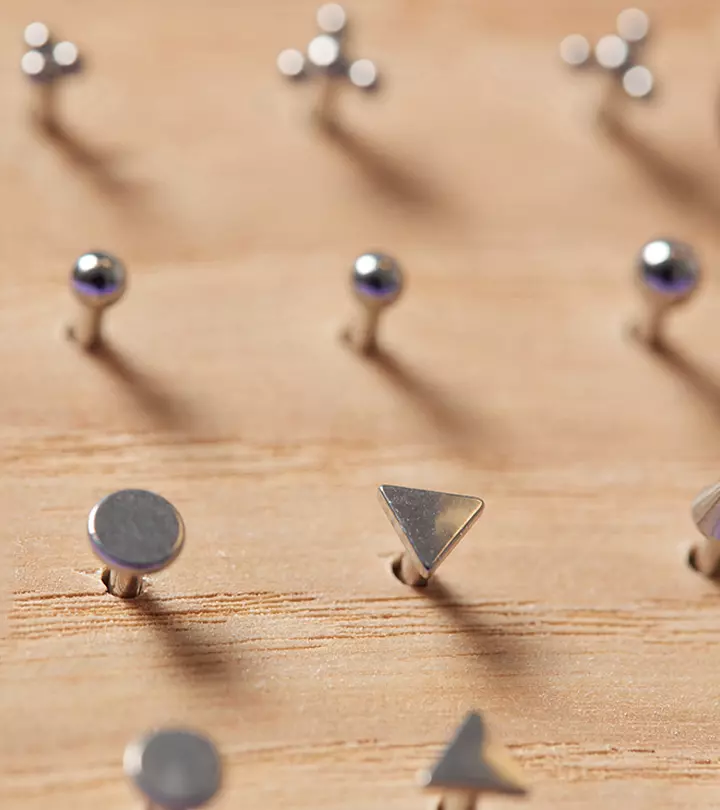
Image: Shutterstock
Getting a new piercing can be quite thrilling, but it is important to figure out the correct piercing gauge size first to ensure your new embellishment sits just right. The gauge size refers to the width of the jewelry’s stem vis-a-vis the piercing hole. Professional piercers usually mention the gauge size they are planning to go for and even use a piercing gauge chart to match the size of the starter jewelry to the freshly pierced hole. Choosing the right gauge size is crucial for the look and comfort of your piercings. It helps reduce the risk of problems like irritation, rejection, or infection, ensuring the piercing heals properly and stays healthy in the long run. Read on to learn more about what piercing gauge size is, why it is important to figure out before getting pierced, and all the different sizes you can go for.
In This Article
What Is A Piercing Gauge?
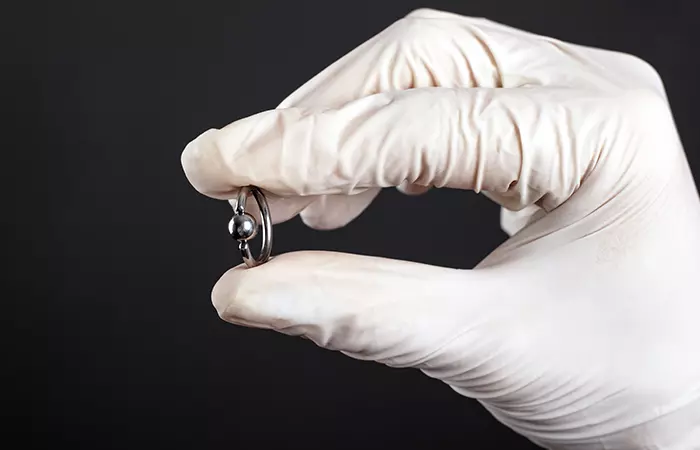
The gauge is the unit used to measure the thickness of the part of the jewelry that goes through the piercing hole. It refers to the width of the jewelry shaft and not the length. This gauge size also helps determine how appropriate the size of the piercing hole is for the jewelry to be inserted. There is an inverse relationship between the gauge size and the size of the barbell, i.e., the bigger the gauge number, the smaller the size of the barbell. For example, a 22G size is thinner than 14G. The sizes range from 22G to 00G, where 18G to 20G is the most commonly preferred size range. Beyond 00G, the gauge size is expressed in terms of their actual sizes, such as ½ inch and so on.
 Trivia
TriviaMost people who take their leap of piercing are unaware of the piercing gauge. Let us explore why you should know the piercing size and how it will benefit you for a smooth piercing experience.
Key Takeaways
- Gauge size is a measure of the thickness of the piercing and not the length of the jewelry.
- Smaller numbers denote thicker jewelry sizes, and larger numbers represent thinner options.
- The standard gauge sizes range from 20G (0.8mm) to 00G (9.3mm)
- Several factors like the location of the piercing, type of jewelry, individual anatomy, and personal preference determine the gauge size.
- If you are aware of your gauge size, you can use the knowledge to unlock advanced techniques, like stretching your piercing.
Why Is It Important To Know Your Piercing Gauge Size?

Understanding your piercing size is essential for a smooth piercing healing process and for long-term comfort. Since the gauge size determines the thickness of the jewelry that goes into the piercing, it impacts the overall look and the healing process. Below are a few reasons for why knowing your gauge piercing size is important.
- While getting a new piercing, the needle will have a certain gauge, and it is essential to use the same gauge measure for the jewelry to avoid rejection or infection.
- Wearing thin gauge jewelry in a larger piercing may cause the piercing to shrink, leading to tearing. Similarly, pain, tearing, and bleeding are common occurrences when you try to force larger gauge jewelry into a thinner piercing hole.
- Very small gauge sizes can cause migration or rejection of the jewelry, as the immune system considers it akin to a sphincter injury (1). But people refrain from larger gauges because they assume they hurt more. There is no such difference between the bearability of larger gauge piercings and smaller sizes, and experts recommend large gauge sizes as they are more stable.
- Different parts of the body have different recommended piercing gauge sizes. This is dependent on the anatomy of the location and the healing specifics. For example, the recommended gauge size for ear lobes is between 20G to 14G. A size below 20G may not offer a successful piercing, as the body may consider it like a splinter and try to push it out.
- If you are someone who pays attention to piercing trends, it is necessary to know about piercing gauges for aesthetic reasons to match the recent trend of thicker body piercings. In contrast to the previous 18G – 20G gauge size trend for ear lobes, 16G or 14G have recently gained popularity.
- Some piercing sites like earlobes and nostrils can be stretched to accommodate a larger gauge, which is also a distinctive aesthetic choice. Understanding gauge sizes can open up a world of advanced body modifications for you to explore as possible options, and your piercer can help with the rest.
Knowing the right gauge size is essential for comfortable and personalized piercings. From thin piercings to stretched statement jewelry, let us help you understand how you can know your piercing size before you buy a suitable piece of body jewelry.
How Do I Know My Piercing Gauge?
As a standard note, the barbell size of body piercings is measured based on a detailed explanation and the type of piercing. But, this is not a mandatory measuring rule, and you can check with your piercer to know the exact gauge size of your current piercing before you pick new jewelry.
It may happen that you buy a body jewelry piece without knowing its gauge size, just because it appealed to you. Well, in such cases, you can use a gauge wheel tool to find the diameter of the barbell. It is a flat wheel with openings that correspond to different gauge sizes. You can slide your jewelry post into the notches till you find the perfect size match.
 Pro Tip
Pro TipHowever, you can plan your piercing gauge size with an idea regarding the standard piercing sizes for different types of body piercings. Dive into the details of the gauge chart before you pick your piece of jewelry.
Standard Piercing Gauge Chart For Body Jewelry
The most common gauge sizes are 20G, 18G, and 16G. People usually start with the 20G size, primarily used for an earlobe piercing. Most surgical steel jewelry is 16G in size. To increase the size of the piercing, you can get 18 G or 16 G jewelry. This size is also suitable for cartilage and high-lobe piercings. Check the table below for standard gauges for different body piercing locations.
The gauge size chart will better help understand the size details with the millimeter measures and piercing types. It is measured as fractions of inches in the US and millimeters internationally.
Standard Gauges For Body Piercing
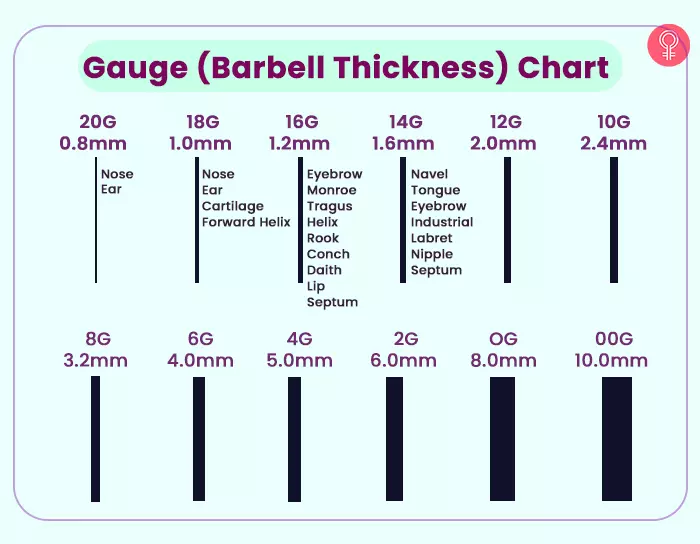
Below is a tabloid representation of the various types of piercings and their standard sizes. Most piercers usually stick to the standard sizing unless requested otherwise.
| Type Of Piercing | Gauge Size |
|---|---|
| Nose Piercing | 20G, 18G |
| Tongue Piercing | 14G |
| Cartilage Piercing | 16G, 18G |
| Eyebrow Piercing | 16G, 14G |
| Industrial Straight Barbell | 14G, 16G |
| Labret Lip Rings | 14G, 16G |
| Monroe Piercing | 16G |
| Nipple Piercing | 14G |
| Belly/Navel Ring | 14G |
| Tragus/Helix/Rook/Conch | 16G, 18G |
| Septum Piercing | 14G, 16G |
| Ear Piercing | 20G, 18G |
With the wide range of studs and hoops available in beautiful styles for the wide variety of piercings, it is beneficial to understand the different sizes of body jewelry available. Learn about the difference between a small and large gauge in the section below.
Difference Between Small And Large Gauges
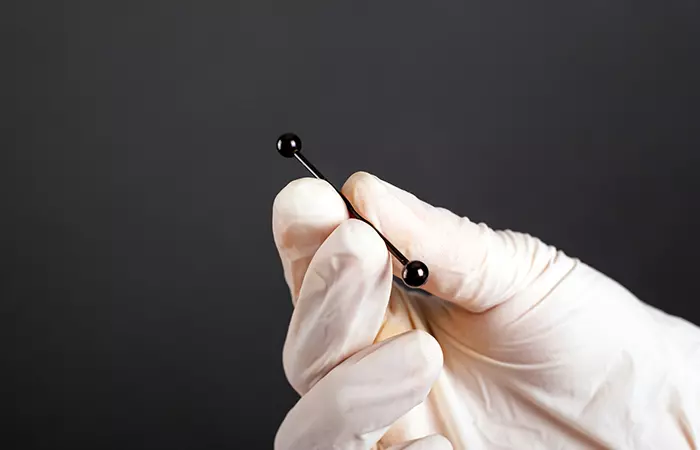
To begin with, gauge sizing may seem slightly confusing. A small gauge means a thinner bar and is labeled a larger gauge number, like 20G. A smaller gauge number like 14G refers to a thicker bar for a larger size. The size difference becomes particularly relevant if you want to stretch your piercing; but otherwise, you just have to remember the specific gauge size of your piercing while choosing the piercing jewelry.
This confusion also arises when using the term “larger gauge.” It means a bigger round but not a larger number of the size. So, if someone says they need a gauge size larger than 14, they are looking for a 12G or a 10G, not 16G. It is kind of like when you want the temperature of the air conditioner to be higher because you feel cold, so you increase the numbers to decrease the cold; basically, the sizes descend (become thinner) as the numbers ascend!
There are various size options to choose from when it comes to piercings, which may make it challenging to find your perfect gauge size if you do not know it. A professional body piercer will match your piercing size with the right jewelry size. But for the times when you are on your own and want to buy yourself a new accessory, always inquire about the gauge size of your piercing from your piercer to ensure you do not end up with something you cannot use.
Frequently Asked Questions
How does gauge size affect piercing aftercare?
The size of the gauge influences how your piercing heals. Larger gauges need more attention because they displace more tissue, which can slow healing. Smaller gauges might heal faster, but proper care can’t be negated to avoid potential issues like infections.
Are there specific materials recommended for different piercing gauge sizes?
The jewelry material choice varies based on durability, weight, affordability, and hypoallergenic properties. Titanium, surgical steel, and gold are the most popular piercing jewelry materials (2).
Can I change my piercing jewelry to a different gauge after healing?
Yes, the gauge size of the piercings can be increased or decreased once healed. You can downsize the piercing size by wearing thinner jewelry of smaller gauge size so that the piercing shrinks. The piercing gauge size can be enlarged using a tapering accessory through stretching.
Do larger gauge sizes hurt more during the piercing process?
A slight increase in the piercing needle size does not significantly impact the piercing pain. Large gauge sizes that displace more tissue can be a little punchier than smaller sizes. However, larger gauge sizes may take longer to heal.
Watch this insightful video of an expert offering clear guidance on determining the gauge size for your piercings. The video includes a quick rundown of the sizes of gauges associated with specific piercings so you can decide what suits you.
References
Articles on StyleCraze are backed by verified information from peer-reviewed and academic research papers, reputed organizations, research institutions, and medical associations to ensure accuracy and relevance. Read our editorial policy to learn more.
- Complications of Body Piercing
https://www.aafp.org/pubs/afp/issues/2005/1115/p2029.html - Jewelry for Initial Piercings
https://safepiercing.org/jewelry-for-initial-piercings/
Read full bio of Ikramul Haque Shazib
Read full bio of Reshma Latif
Read full bio of Madhumati Chowdhury
Read full bio of Joyce Joyson






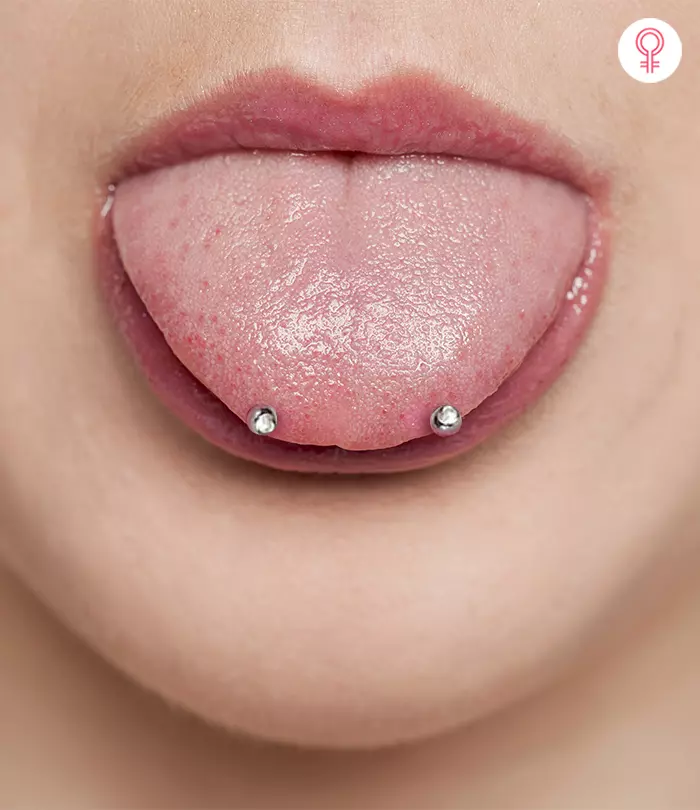
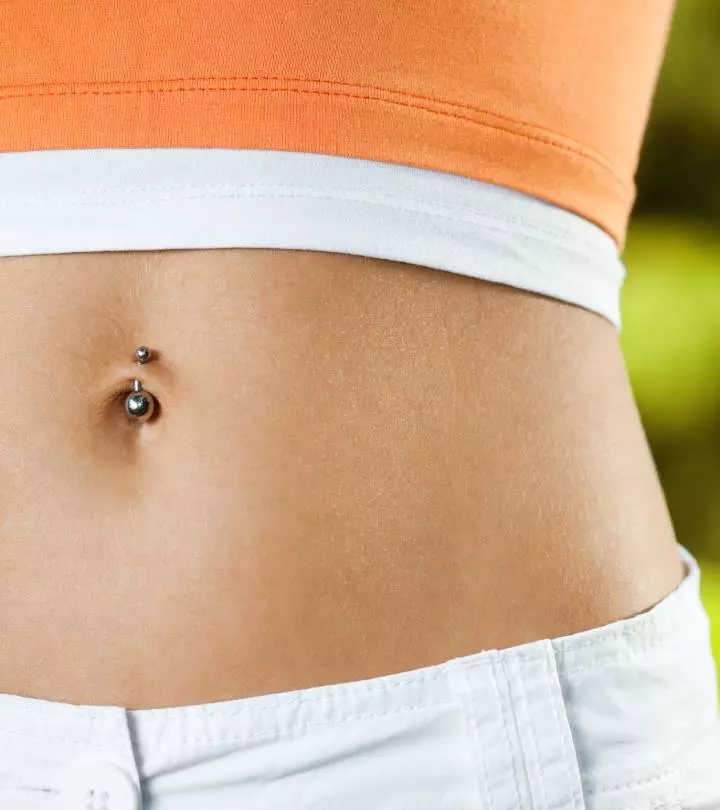

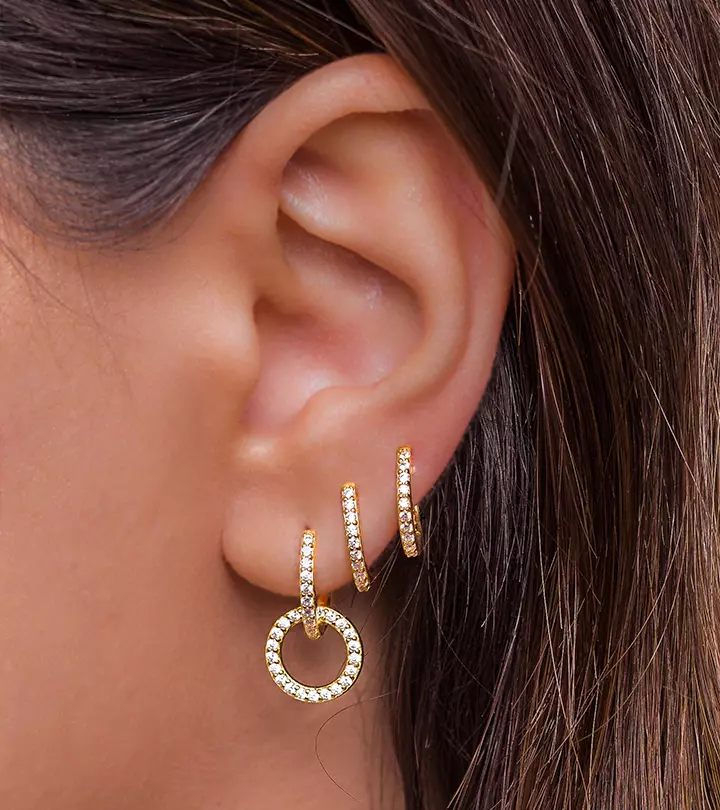
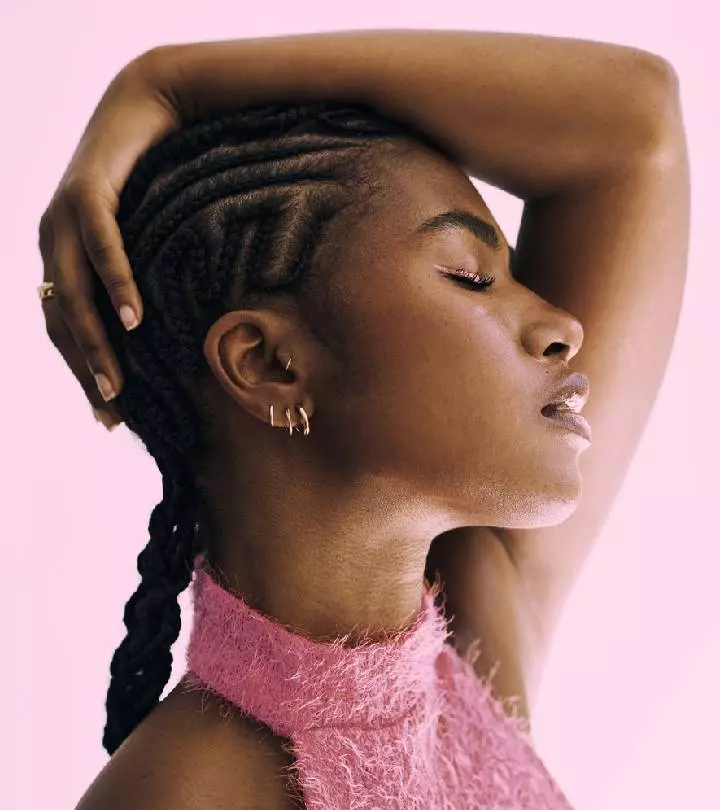
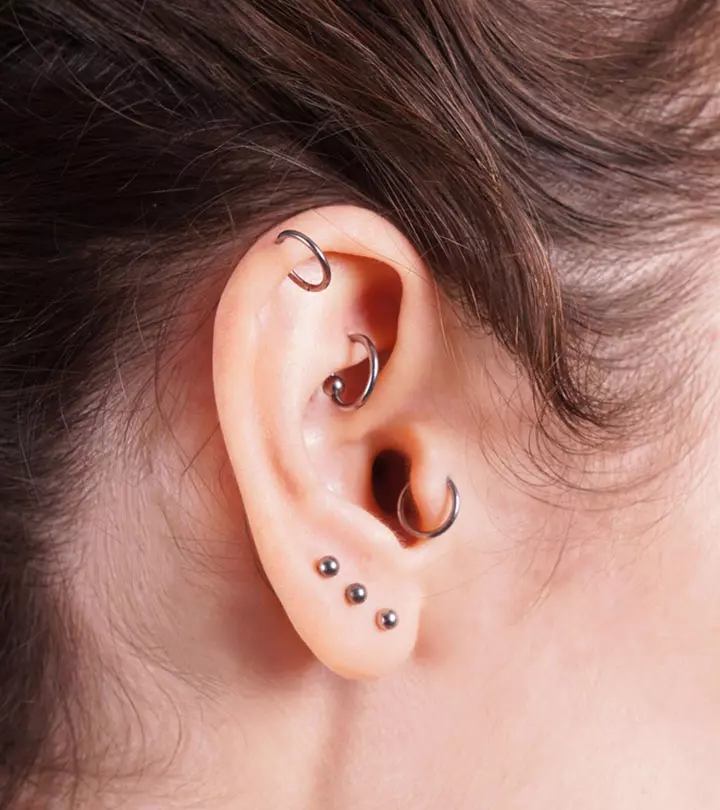


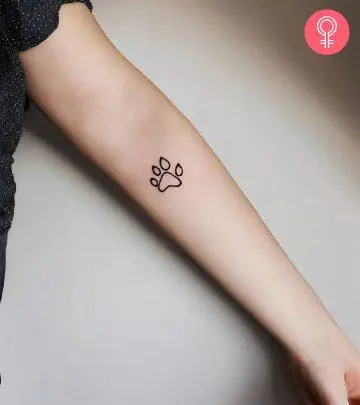


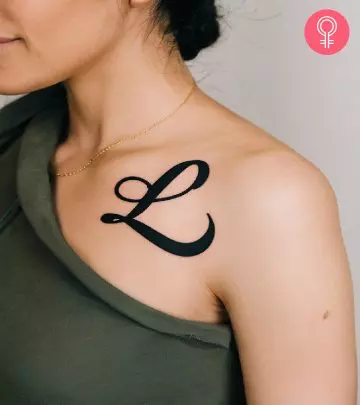


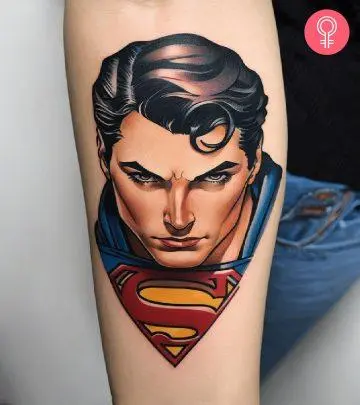
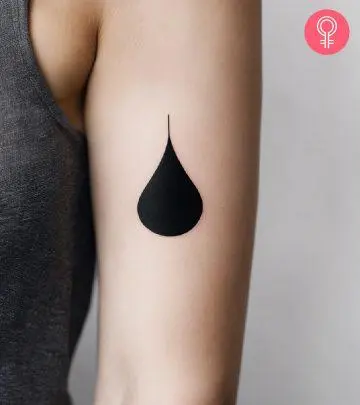
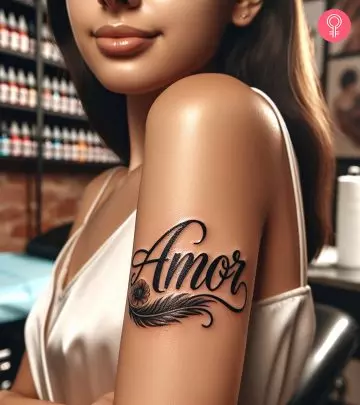
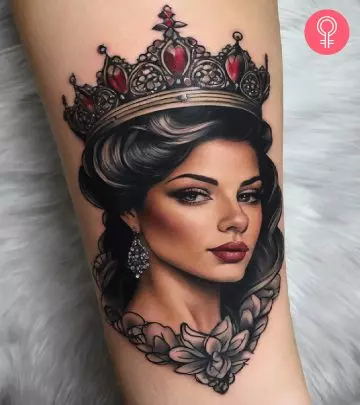
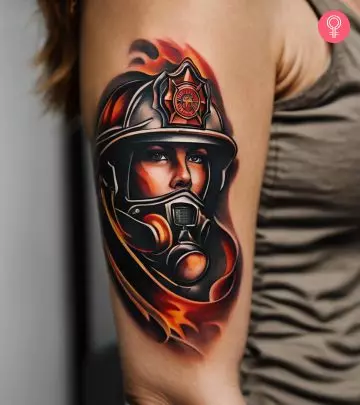
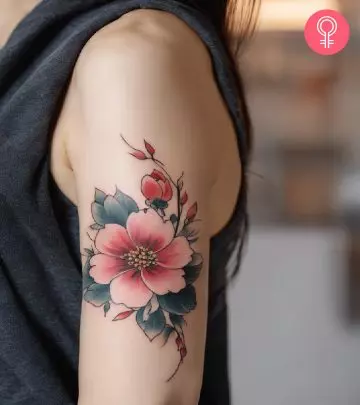
Community Experiences
Join the conversation and become a part of our empowering community! Share your stories, experiences, and insights to connect with other beauty, lifestyle, and health enthusiasts.